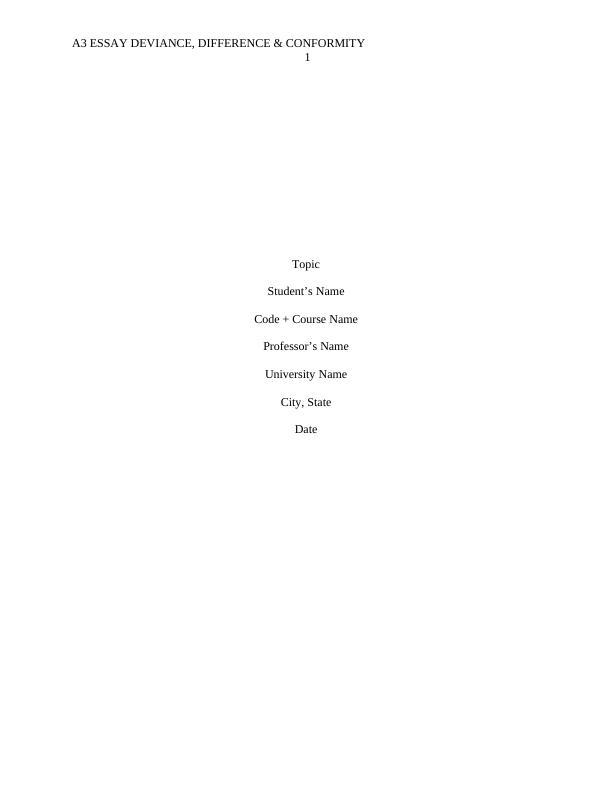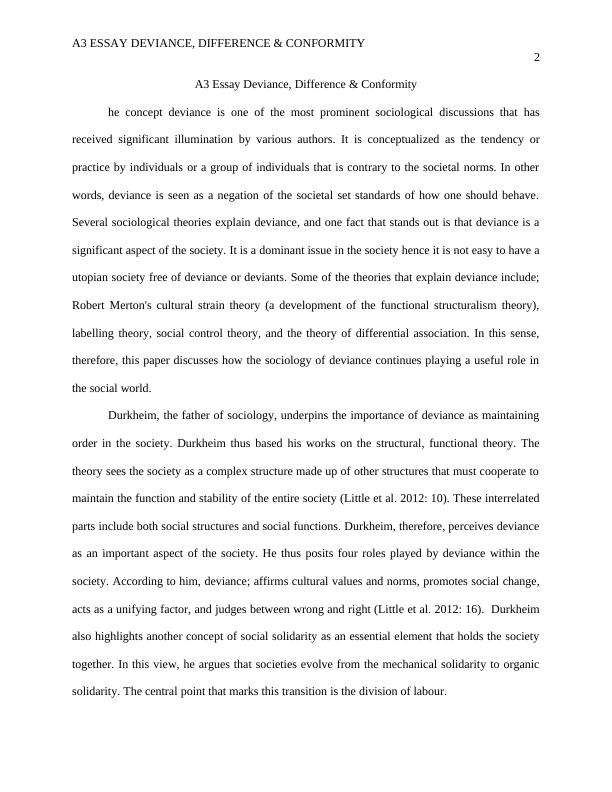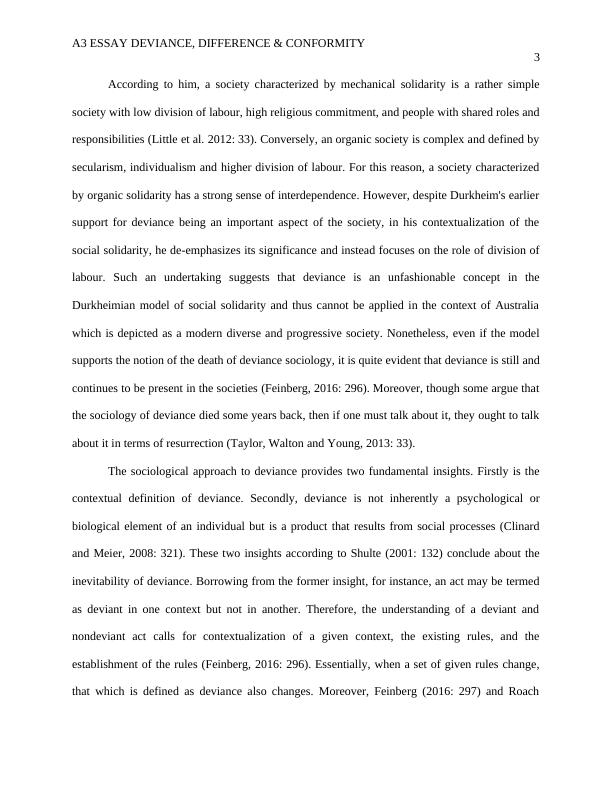Ask a question from expert
Paper On Sociology Of Deviance - Desklib
8 Pages2308 Words171 Views
Added on 2020-02-24
Paper On Sociology Of Deviance - Desklib
Added on 2020-02-24
BookmarkShareRelated Documents
A3 ESSAY DEVIANCE, DIFFERENCE & CONFORMITY1TopicStudent’s NameCode + Course NameProfessor’s NameUniversity NameCity, StateDate

A3 ESSAY DEVIANCE, DIFFERENCE & CONFORMITY 2A3 Essay Deviance, Difference & Conformityhe concept deviance is one of the most prominent sociological discussions that hasreceived significant illumination by various authors. It is conceptualized as the tendency orpractice by individuals or a group of individuals that is contrary to the societal norms. In otherwords, deviance is seen as a negation of the societal set standards of how one should behave.Several sociological theories explain deviance, and one fact that stands out is that deviance is asignificant aspect of the society. It is a dominant issue in the society hence it is not easy to have autopian society free of deviance or deviants. Some of the theories that explain deviance include;Robert Merton's cultural strain theory (a development of the functional structuralism theory),labelling theory, social control theory, and the theory of differential association. In this sense,therefore, this paper discusses how the sociology of deviance continues playing a useful role inthe social world. Durkheim, the father of sociology, underpins the importance of deviance as maintainingorder in the society. Durkheim thus based his works on the structural, functional theory. Thetheory sees the society as a complex structure made up of other structures that must cooperate tomaintain the function and stability of the entire society (Little et al. 2012: 10). These interrelatedparts include both social structures and social functions. Durkheim, therefore, perceives devianceas an important aspect of the society. He thus posits four roles played by deviance within thesociety. According to him, deviance; affirms cultural values and norms, promotes social change,acts as a unifying factor, and judges between wrong and right (Little et al. 2012: 16). Durkheimalso highlights another concept of social solidarity as an essential element that holds the societytogether. In this view, he argues that societies evolve from the mechanical solidarity to organicsolidarity. The central point that marks this transition is the division of labour.

A3 ESSAY DEVIANCE, DIFFERENCE & CONFORMITY 3According to him, a society characterized by mechanical solidarity is a rather simplesociety with low division of labour, high religious commitment, and people with shared roles andresponsibilities (Little et al. 2012: 33). Conversely, an organic society is complex and defined bysecularism, individualism and higher division of labour. For this reason, a society characterizedby organic solidarity has a strong sense of interdependence. However, despite Durkheim's earliersupport for deviance being an important aspect of the society, in his contextualization of thesocial solidarity, he de-emphasizes its significance and instead focuses on the role of division oflabour. Such an undertaking suggests that deviance is an unfashionable concept in theDurkheimian model of social solidarity and thus cannot be applied in the context of Australiawhich is depicted as a modern diverse and progressive society. Nonetheless, even if the modelsupports the notion of the death of deviance sociology, it is quite evident that deviance is still andcontinues to be present in the societies (Feinberg, 2016: 296). Moreover, though some argue thatthe sociology of deviance died some years back, then if one must talk about it, they ought to talkabout it in terms of resurrection (Taylor, Walton and Young, 2013: 33). The sociological approach to deviance provides two fundamental insights. Firstly is thecontextual definition of deviance. Secondly, deviance is not inherently a psychological orbiological element of an individual but is a product that results from social processes (Clinardand Meier, 2008: 321). These two insights according to Shulte (2001: 132) conclude about theinevitability of deviance. Borrowing from the former insight, for instance, an act may be termedas deviant in one context but not in another. Therefore, the understanding of a deviant andnondeviant act calls for contextualization of a given context, the existing rules, and theestablishment of the rules (Feinberg, 2016: 296). Essentially, when a set of given rules change,that which is defined as deviance also changes. Moreover, Feinberg (2016: 297) and Roach

End of preview
Want to access all the pages? Upload your documents or become a member.
Related Documents
Marx and Durkheim on Modern Societylg...
|8
|2173
|401
Durkheim’s Assertion that “Crime is Normal”: A Critical Discussionlg...
|8
|2154
|329
Criminology- Punishments and penology ESSAYlg...
|8
|2138
|227
Usefulness of Structural–Functionallg...
|6
|1307
|29
Functionalist Approach to Gender Roles in Societylg...
|4
|856
|49
Perspectives on Sociological Theorieslg...
|11
|3250
|190